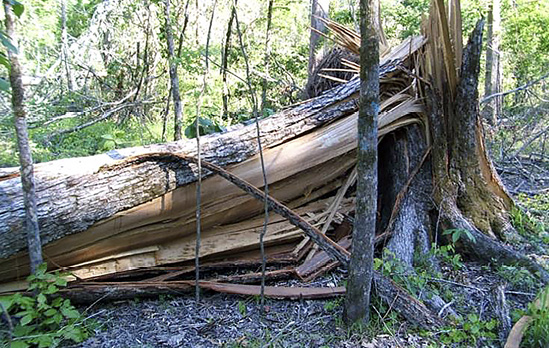Disaster Relief: Clearing Debris from Land

You alone are responsible for clearing debris from your property after a damaging natural event.
Determine Priorities
Here are some guides for setting priorities for clearing debris from land after a severe storm:
- Land use and value—Clear streets and roads to allow emergency vehicles to pass freely. In yards and pastures, remove any lumber containing nails or other pieces of metal that could injure people and/or livestock. Pay special attention to avoid contact with downed electrical lines and other utilities.
- Equipment available—Power saws, tractors, bulldozers, and trucks can be used to move fallen trees. If you have access to only small equipment, remove tree roots and small limbs before attempting to clear the area.
- Type of debris—Different vegetation often requires different cleanup and salvage procedures. In woodlots and forests, experienced foresters should designate salvageable timber. You may need specialized equipment to clear large areas efficiently.
Remove Debris
Here are some ways you can remove tree debris:
Bulldozing
- Inspect damaged trees to see if salvage is a viable option. Contact a certified arborist or horticulturist for this work.
- Remove valuable trees before clearing debris.
- If possible, use a bulldozer with a root rake attached. This type of rake will let most of the soil pass through the teeth, reducing topsoil removal and creation of undesirable mounds of soil in unwanted areas.
- If stump removal is desired and you plan to use bulldozers, leave stumps 6 to 10 feet high for leverage. If you use a stump grinder, remove trees at ground level.
Burial
You can bury tree debris, but it is expensive. Use a chipping machine for smaller branches to reduce the burial space you need.
Landfill
You can put tree debris in eroded gullies (where the land is not practical for terracing) or in low-lying areas. Consult a water-resource specialist to determine how the landfill will change the water’s path and does not negatively impact downstream water quality. Typically a bulldozer or other large equipment is needed for this work. It can be dangerous to use smaller tractors to push debris into gullies.
Burning
Let trees dry to the point where foliage begins to fall off. Put debris in large compact piles a safe distance from surrounding structures or other flammables. Fuel oils may be necessary to ensure combustion. If so, exercise extreme caution and maintain a safe distance when igniting debris piles. Stoke piles and keep fire alive until all woody material is burned. In some areas, you may need a permit to burn debris, and it may be prohibited in some communities because of smoke pollution. Burning may also be prohibited under burn bans when environmental factors result in unsafe burning conditions.
Safety
Remember, safety always comes first. Even if you regularly work with damaged or fallen timber, observe safety precautions to prevent injury or death.
- Stabilize ladders when pruning trees, or climb into trees to prune. Use a safety rope.
- Watch for falling limbs.
- Be careful of electric power lines. Leave pruning around power lines to power companies. Wet limbs or soiled control ropes on pruning equipment can be hazardous. Do not use pruning equipment with metal handles.
- If you have never used a chain saw before, try to find someone with experience to help you after a disaster. If you are experienced with chain saws, observe all safety precautions. Use a sharp saw and shut it off even when moving only a few feet. Remember that people can’t hear you shout and you can’t hear warnings when the saw is running.
- Clear the area before beginning to saw limbs or trees. Determine the direction the tree will fall. Try to limit felling trees into other trees. Plan an escape route in case the tree jumps off the stump when cut.
The information given here is for educational purposes only. References to commercial products, trade names, or suppliers are made with the understanding that no endorsement is implied and that no discrimination against other products or suppliers is intended.
Publication 3884 (POD-04-23)
Reviewed by A. Brady Self, PhD, Assistant Extension Professor, Forestry. From The Disaster Handbook - 1998 National Edition, University of Florida/Institute of Food and Agricultural Sciences SP 2431.
The Mississippi State University Extension Service is working to ensure all web content is accessible to all users. If you need assistance accessing any of our content, please email the webteam or call 662-325-2262.







